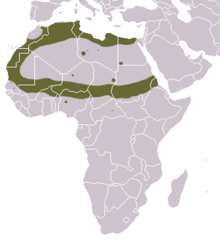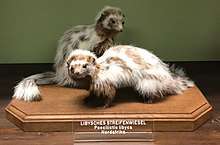Saharan striped polecat
The Saharan striped polecat, also known as the Saharan striped weasel, Libyan striped weasel, and the North African striped weasel (Ictonyx libycus) is a species of mammal in the family Mustelidae.[2] This animal is sometimes characterized as being a part of the genus Poecilictis, and its coloration resembles that of the striped polecat.[3]
| Saharan striped polecat | |
|---|---|
 | |
| Scientific classification | |
| Kingdom: | Animalia |
| Phylum: | Chordata |
| Class: | Mammalia |
| Order: | Carnivora |
| Family: | Mustelidae |
| Genus: | Ictonyx |
| Species: | I. libycus |
| Binomial name | |
| Ictonyx libycus | |
 | |
| Saharan striped polecat range | |
Physical characteristics
Saharan striped polecats are about 55–70 cm in length, including their tails, and generally weigh between .5 and .75 kg. It is striped white in a non-uniform fashion and has black feet, legs, ears, and underside. Often a white ring goes around the face and above a black snout. It is sometimes confused with the striped polecat though it is generally smaller and has distinct facial markings.[4]
Distribution
The Saharan stripe polecat is distributed around the northern and southern edges of the Sahara Mauritania, Western Sahara and Morocco in the west along the Mediterranean littoral of North Africa to the Nile Valley in Egypt, while in the south its range is the Sahel east to Sudan and Djibouti.[1][5]
Habitat
The Saharan striped polecat is found on the margins of deserts especially in mountains, in arid stony terrain and sandy semideserts, rarely seen in woodlands and is prefers steppe like habitat.[6]
Habits
Diet
It eats a diet primarily of eggs, small birds, small mammals, and lizards.[7] Much of its prey is tracked down by scent and dug out of burrows, and although it is normally a slow, deliberate mover it can move quite rapidly and pounce quickly when pursuing prey.[6]
Lifestyle and reproduction
The Saharan striped polecat is nocturnal and solitary. It hides during the day in other animals' burrows or digs its own. It generally gives birth to one to three young in spring.[4]
Defense mechanisms
This creature is known to spray a foul, skunk-like anal emission when threatened.[2] It moves about at night in the open in a quite deliberate way with its tail held vertically.[6] Before releasing the anal emission it will raise its fur in an attempt to warn the potential attacker.[7]

Relation with humans
In Tunisia these animals are often caught and exploited because of the tribal belief that they may increase male fertility.[1]
Subspecies
- Ictonys libycus libycus
- Ictonys libycus multivittatus
- Ictonys libycus oralis
- Ictonys libycus rothschildi[5]
References
- Ahmim, M. & Do Linh San, E. (2015). "Ictonyx libyca". IUCN Red List of Threatened Species. 2015: e.T41645A45212347.
- Newman, Buesching & Wolff (2005). The function of facial masks in midguild carnivores (PDF). Oxford: Wildlife Conservation Research Unit, Dept of Zoology. p. 632.
- Ball, Marion (1 January 1978). "Reproduction in captive-born zorillas". International Zoo Yearbook. 18 (1): 140–143. doi:10.1111/j.1748-1090.1978.tb00245.x.
- Hoath, Richard (2009). A Field Guide to the Mammals of Egypt. Egypt: The American University in Cairo Press. pp. 82–84. ISBN 9789774162541.
- "Saharan Striped Polecat". theanimalfiles.com. Retrieved 2016-11-17.
- Kingdon, J. (1997). The Kingdon Field Guide to African Mammals. Academic Press. p. 229. ISBN 978-0-12-408355-4.
- Hoath, Richard (2009). A Field Guide to the Mammals of Egypt. Egypt: The American University in Cairo Press. p. 83. ISBN 9789774162541.
